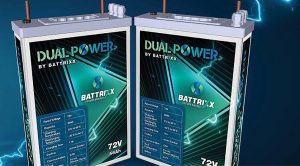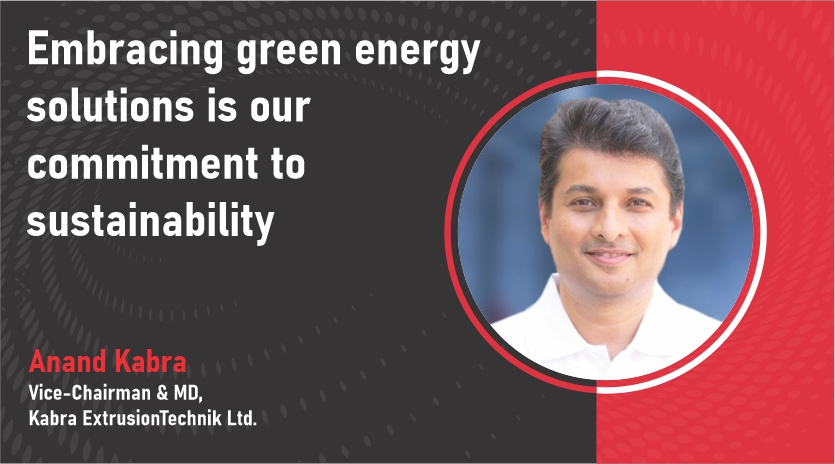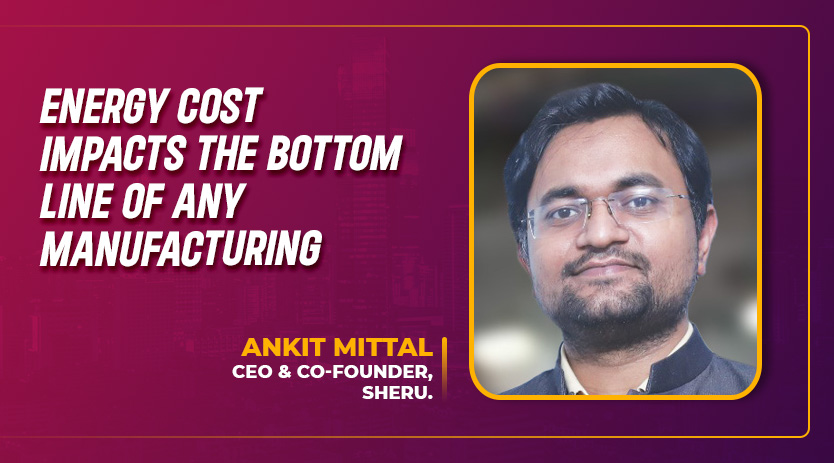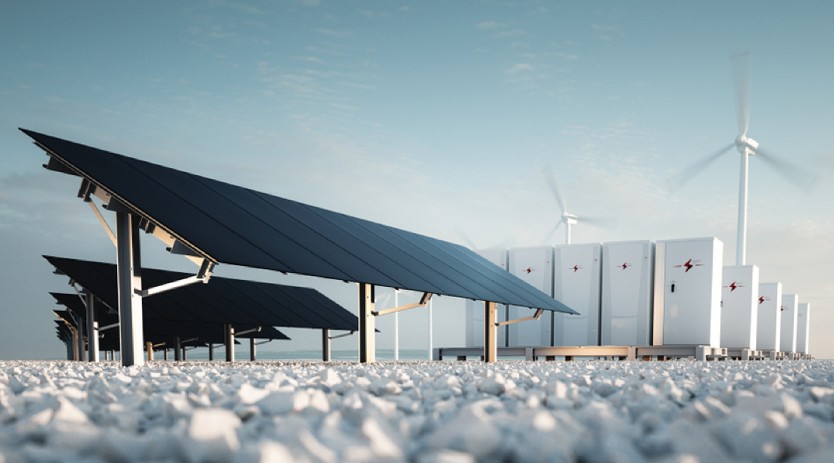Embracing green energy solutions is our commitment to sustainability
June 9, 2023 3:32 pm
Talking about battery manufacturing, Anand Kabra, Vice-Chairman & MD, Kabra ExtrusionTechnik Ltd., most batteries can be effectively refurbished and reused. In contrast, worn-out batteries offer significant potential for recycling to ensure the environmental safety.
How do your solutions empower sustainability in the manufacturing unit?
We actively contribute to mitigating the environmental impact of transportation by serving the top 5 OEMs leading the electric vehicle revolution. Our batteries power electric vehicles, offering a cleaner and more sustainable alternative to fossil fuel-based transportation. By supporting these OEMs, we accelerate electric vehicle adoption, thus reducing carbon emissions in manufacturing and transportation. Our commitment to sustainability is further exemplified through our emphasis on green energy systems and solutions. Our Battery Management Systems (BMS) and Energy Storage solutions enable efficient utilisation of renewable energy sources, reducing dependence on non-renewable energy and promoting clean and sustainable power in our manufacturing operations.
Our commitment to sustainability is demonstrated through our ongoing research and development endeavours to explore innovative chemistries and technologies for battery production. By investigating alternative options like solid-state and lithium-sulfur batteries, we strive to enhance energy storage efficiency, reduce reliance on limited resources, and minimise environmental impact. Furthermore, our focus on thermal management solutions and adherence to strict safety standards ensure our batteries’ secure and effective operation. Incorporating advanced cooling systems, early detection mechanisms, and protective measures against external abuse, we mitigate the risk of battery failures and potential environmental hazards. Our solutions promote sustainability by driving electric vehicle adoption, facilitating renewable energy integration, enhancing energy efficiency, and prioritising safety and environmental responsibility in our manufacturing processes.

What key practices and approaches can manufacturing companies adopt to promote sustainable manufacturing?
Benefits from sustainable manufacturing practices can be broadly classified under the positive impact on the environment, resource efficiency, waste management and recycling.
The manufacturing sector has historically been associated with waste generation and inadequate waste management. However, there is now a conscious effort among manufacturing companies to adopt new practices that prioritise waste management and recyclable solutions. This shift aims to improve the industry’s reputation and bring about substantial change by maximising material reuse. In battery manufacturing, most batteries can be effectively refurbished and reused, while worn-out batteries offer significant potential for recycling. Moreover, retired EV batteries can be repurposed and recycled using existing methods, opening up new possibilities for future applications with lower energy requirements. Although India is in the early stages of EV deployment, such practices will gradually develop, contributing to a more sustainable manufacturing landscape.
While the positive environmental impact is crucial, manufacturing companies should prioritise resource optimisation without burdening the environment. Sustainable manufacturing focuses on efficiently utilising resources, such as raw materials, energy, and water, to minimise waste generation, enhance resource efficiency, conserve valuable resources, and promote circular economy principles.
How does Battrixx incorporate various battery chemistries and advanced manufacturing practices?
At Battrixx, we have implemented several technological advancements in our manufacturing practices to enhance our batteries’ safety, performance, and reliability. Firstly, we utilise various chemistries such as lithium iron phosphate (LFP), lithium manganese oxide (LMO), lithium cobalt oxide (LCO), lithium nickel cobalt aluminium (NCA), lithium nickel cobalt manganese (NCM), and lithium titanate oxide (LTO) to cater to different application requirements.
Apart from the existing lithium-ion technology, we are actively engaged in researching and developing alternative battery chemistries that have the potential to become the future industry standard. These include solid-state batteries, lithium-ion batteries with high nickel and silicon content, lithium-sulfur batteries, lithium-metal batteries, lithium-air batteries, sodium-ion batteries, aluminium-ion batteries, magnesium-ion batteries, and zinc-air batteries. In terms of manufacturing practices, we prioritise two key aspects.
Firstly, we employ active and passive thermal management solutions to ensure safe battery temperatures. We incorporate temperature-sensitive devices such as fuses, vents, IP ratings, and early detection systems to monitor and regulate cell temperature. Secondly, we emphasise the importance of thermal management and cooling for battery packs. While active cooling systems may be costly, we are actively working on developing cost-effective solutions.
Government regulations should mandate certain components and standards to ensure battery safety and performance, especially for entry-level models with crucial upgrades. Through close collaboration with local design teams and the support of global technology partners, we have successfully developed solutions such as active and passive cooling mechanisms and protective measures against external abuse, thermal shocks, and water ingress. We actively encourage our OEM partners to adopt these safety standards; many have upgraded their battery packs accordingly. By incorporating these technological advancements into our manufacturing practices, Battrixx is committed to delivering high-quality, safe, and reliable batteries while continuously pushing the industry’s innovation boundaries.
How does Battrixx leverage 3D printing technology and AI-based algorithms to enhance its product development process?
The EV and Lithium Battery Industry is a dynamic and ever-evolving sector with constant technological advancements. At Battrixx, we utilise 3D Printing Technology extensively to validate our products. By creating 3D-printed parts, we can assess the impact of design changes at a component level, allowing us to develop prototypes and final products that meet and exceed customer expectations well in advance.
The current Battery Management System continuously log data related to various Parameters related to Battery Health and Performance. The data we retrieved by BATTRIXX made IOT System and saved it in the BATTRIXX server. We are working on AI-based algorithms that can help the Battery and vehicle function efficiently and take action well before the emergency condition by Predictive analysis.
Please discuss how your range of solutions can impact green practices.
The global urgency to tackle vehicular emissions and combat urban air pollution has sparked a widespread transition to cleaner fuels and electric vehicles (EVs). Battrixx takes pride in contributing to this movement by developing environmentally-friendly energy systems and solutions aligned with our commitment to sustainability. Our endeavours are not merely futuristic concepts; they are already making a tangible impact in regions prioritising a higher purpose. Through our Battery Management Systems (BMS), we power EVs, reducing reliance on fossil fuels and promoting cleaner modes of transportation. Furthermore, our Energy Storage Solutions offer efficient and eco-conscious power solutions for residential and commercial spaces.
By creating these alternative energy solutions, we provide innovative products and lay the groundwork for a greener and more promising future. Transitioning to electric vehicles is pivotal in curbing fossil fuel consumption and mitigating the greenhouse gas emissions that drive climate change. Electric vehicles hold the potential to enhance the quality of life, particularly in polluted and congested urban areas, while also fostering the development of smarter and more efficient transportation systems.
Realising these visionary concepts necessitates collective efforts from governments, regulatory bodies, automobile manufacturers, and battery producers. Battrixx finds itself at a critical juncture, wholly dedicated to sustainable innovation and playing a crucial role in powering the present and future of electric vehicles through our green energy systems.
A key aspect of ensuring safe, reliable, and long-lasting battery operation is customising the Battery Management System (BMS) to the specific environment. Drawing on over a decade of experience building BMSs, we involve customers at every stage, tailoring existing BMS designs with proprietary algorithms to perfectly align with their design needs.
Our BMS solutions encompass a range of key features, including robust state of charge (SOC), cell balancing, and state of health (SOH) estimation algorithms. Communication capabilities are integrated through various protocols such as CAN, RS 485, RS 232, and IoT (Bluetooth, GPS) for seamless connectivity. Our BMSs ensure efficient charging performance by communicating with charging stations and performing necessary handshaking procedures. Safety is a top priority, and our BMSs comply with relevant standards such as AIS 004, AIS 048, CISPR, and ASIL D, offering protections against overvoltage, Undervoltage, over-temperature, under-temperature, overcurrent, short circuit, and sustaining capacity requirements.
Through these advanced BMS solutions, Battrixx is empowering the green revolution in the automotive industry and promoting the widespread adoption of electric vehicles for a cleaner, healthier, and more sustainable future.
What major challenges do you see in modernising Indian manufacturing facilities?
Modernising Indian manufacturing facilities face several challenges, including supply chain management, cost considerations, indigenous manufacturing, and recycling. Firstly, promoting domestic production of critical components, technologies, and equipment can reduce dependence on imports and establish India as a self-sufficient manufacturing hub. This requires encouraging innovation, supporting research and development, and creating a conducive environment for domestic manufacturing. Secondly, adopting appropriate procurement strategies is crucial to optimise costs and enhance competitiveness. This involves sourcing materials and components at competitive prices, exploring local manufacturing capabilities, and capitalising on economies of scale. Prioritising cost reduction can improve the cost-effectiveness and global competitiveness of Indian manufacturing facilities. The recent discovery of lithium reserves presents a potential opportunity for key components in the EV sector, although it is too early to determine the full impact.
How does Battrixx plan to increase its market share and establish a strong presence in the electric three-wheeler and four-wheeler segments?
Battrixx currently supplies lithium-ion batteries to electric two-wheeler OEMs, with a monthly production capacity of 20,000 batteries. We are proud to serve five of India’s top ten OEMs and hold an 18% market share as of FY23. Our company aims to penetrate the electric three-wheeler segment in the upcoming quarters, including light commercial vehicles and electric four-wheelers.
To meet the anticipated surge in EV demand, Battrixx has invested INR 200 crore in the division and commenced commercial production in Q4FY20. Our division has a capacity of 200,000 battery packs as of Q2FY23, which is expected to reach 700,000 by FY24. We are developing batteries ranging from 2 KWh to 30 KWh capacities to cater to diverse needs.
To establish a strong presence in the market, companies must invest in capital, testing facilities, equipment, and automation for battery manufacturing. This includes improving thermal efficiency by redesigning battery packs, integrating high-quality cells and battery management systems, and implementing water protection mechanisms. Battrixx is already making strides in this direction by developing an in-house 100% test facility and plans to enhance its testing capabilities further. Notably, Battrixx was one of the first battery pack manufacturers to obtain AIS 156 Phase 2 certification in the previous quarter.
With the EV industry in India holding great promise, Battrixx maintains an optimistic outlook for its future growth. The company has a robust capital expenditure plan focused on achieving an annual battery pack capacity of approximately 2 GW by FY24. Furthermore, Battrixx actively explores new markets, expands its customer base, and aims to increase its market share. In FY24, the company plans to enter the E-3-Wheeler battery pack market while continuing its efforts in E-4-Wheeler battery pack applications.
Cookie Consent
We use cookies to personalize your experience. By continuing to visit this website you agree to our Terms & Conditions, Privacy Policy and Cookie Policy.










